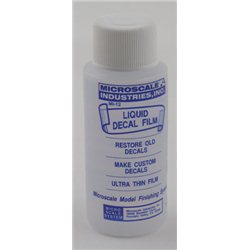Brake vans (originally called break vans) were first employed on early industrial tramways and cableways to provide...
No products
Product successfully added to your shopping cart
There are 0 items in your cart. There is 1 item in your cart.
Search Tips
Can I repair decals already in place on a model?
Occasionally there is a need to repair existing decals, either before or after application. Waterslide decals are produced on a waterproof but water-soluble medium which allows for easy transfer to a model. Unfortunately, older decal sheets supplied with vintage models are prone to time-related degradation. In effect, the decal carrier film will start to degrade and lose its integrity causing it to break up in water. Exposure to sunlight can significantly exacerbate this process.
Microscale Liquid decal Film can help overcome this process. Liquid Decal Film can be applied to the decal sheet with a hobby brush before immersion in water. This creates a new film on top of the old decal which will hold the decal together when it is immersed in water. Additionally, Liquid Decal Film can be applied to decals already on a model where the carrier film is starting to break up. With careful application via a hobby brush, Liquid Decal Film forms a new, thin carrier film over the damaged decal, effectively holding it together.
Once allowed to dry it is then good practice to seal the repaired decal with a coat of varnish, as this will help protect the decal from further damage and increase its longevity.
Click here to receive the tips weekly in your mailbox. You can unsubscribe at any time.








